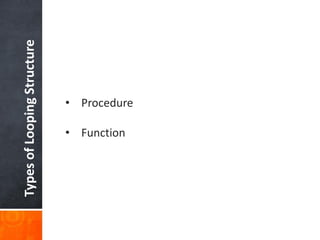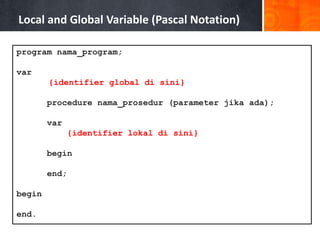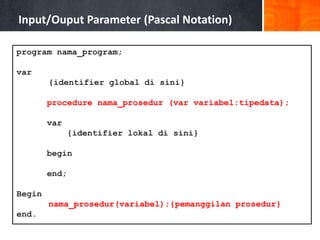Algorithm and Programming (Procedure and Function)
- 1. Adam Mukharil Bachtiar English Class Informatics Engineering 2011 Algorithms and Programming Procedure and Function
- 2. Steps of the Day Let’s Start Modular Programming Procedure Function
- 3. Modular Programming Definition and Types of Modular Programming
- 4. BackgroundofModular Programming Make a program to solve all problems in your calculus book! WHAT WILL YOU DO?
- 6. ThinkinginModular Programming Breakdown a big problem into several small problems. Small Problems can be reconstructed to solve the big problem.
- 7. ThinkinginModular Programming MainProgram Sub Program 1 Sub Program 2 Sub Program 3
- 8. WhatisModularProgramming Programming technique that break main program into several sub program.
- 9. BenefitsofModular Programming • Eliminate repetition of same syntax in program or algorithm. • Can find syntax error easily. • Easy to make big program.
- 11. Procedure Definition and Structures of Procedure
- 12. WhatisProcedure Instruction block that was made specially to do specific job.
- 13. ExampleofProcedure (SleepProcedure) • Brush your teeth • Go to bed • Pray • Cover your body with bedcover • Count the sheep (if you are insomnia) • Start to dream • Wake up (if you are not death) • Pray again
- 14. Format of Procedure (Algorithm Notation) Procedure NamaProsedur (Parameter jika ada) {I.S.: Keadaan awal sebelum prosedur dijalankan} {F.S.: Keadaan akhir sesudah prosedur dijalankan} Kamus: {Variabel, konstanta, tipe buatan lokal} Algoritma: {Badan Prosedur, Berisi instruksi} EndProcedure
- 15. Format of Procedure (Pascal Notation) procedure NamaProsedur (Parameter jika ada); {Variabel, konstanta, tipe buatan} begin {Badan Prosedur, Berisi instruksi} end;
- 17. Example of Procedure (Algorithm) 1 2 3 4 5 6 7 8 9 10 11 12 13 Procedure HitungLuasPersegi {I.S: Diinputkan sisi oleh pengguna} {F.S: Menampilkan hasil perhitungan luas persegi di layar} Kamus: sisi:integer luas:integer Algoritma: input(sisi) luas sisi * sisi output(‘Luas Persegi = ‘,luas) EndProcedure
- 18. Example of Procedure (Pascal) 1 2 3 4 5 6 7 8 9 10 11 12 13 procedure HitungLuasPersegi; var sisi:integer; luas:integer; begin write(‘Masukan sisi : ‘);readln(sisi); luas sisi * sisi; writeln(‘Luas Persegi = ‘,luas); write(‘Tekan sembarang tombol untuk keluar...’); readkey(); end;
- 19. CalltheProcedure Procedure was useless until you call it in main algorithm, main program, or the other modul.
- 20. Format of Calling Procedure (Algorithm) NamaProsedur Atau NamaProsedur(parameter jika ada)
- 21. Format of Calling Procedure (Algorithm) NamaProsedur; Atau NamaProsedur(parameter jika ada);
- 23. Example of Calling Procedure (Algorithm) 1 2 3 4 5 6 7 8 9 10 11 12 Algoritma PanggilHitungLuasPersegi {I.S: Diinputkan sebuah bilangan oleh pengguna} {F.S: Memanggil prosedur sebanyak bilangan} Kamus: i,bil:integer {kamus global} procedure HitungLuasPersegi {Cukup Headernya saja} Algoritma: input(bil) for i 1 to bil do HitungLuasPersegi {memanggil prosedur} endfor
- 24. Example of Calling Procedure (Pascal) 1 2 3 4 5 6 7 8 9 10 11 12 13 program PanggilHitungLuasPersegi; uses crt; var bil:integer; {Prosedur HitungLuasPersegi kamu diletakkan di sini} begin write(‘Masukan bilangan = ‘);readln(bil); for i 1 to bil do HitungLuasPersegi; {memanggil prosedur} {Baris penutup jangan sampai lupa!!!} end.
- 25. TypesofVariable • Global Variable • Local Variable
- 26. GlobalVariable Varible that was known by entire program or algorithm. This variable was declared in main program or main algorithm.
- 27. LocalVariable Varible that was known only by its owner. This variable was declared inside procedure or function.
- 28. Local Variable (Algorithm Notation) Procedure NamaProsedur (Parameter jika ada) {I.S.: Keadaan awal sebelum prosedur dijalankan} {F.S.: Keadaan akhir sesudah prosedur dijalankan} Kamus: {Identifier lokal diletakkan di sini} Algoritma: {Badan Prosedur, Berisi instruksi} EndProcedure FORMAL PARAMETER
- 29. Global Variable (Algorithm Notation) Algoritma judul_algoritma {I.S.: diisi keadaan yang terjadi di awal algoritma} {F.S.: diisi keadaan yang terjadi di akhir algoritma} Kamus/Deklarasi: {Identifier global diletakkan di sini} Algoritma/Deskripsi: {diisi dengan input, proses, dan output}
- 30. Local and Global Variable (Pascal Notation) program nama_program; var {identifier global di sini} procedure nama_prosedur (parameter jika ada); var {identifier lokal di sini} begin end; begin end.
- 32. WhatisParameter Variable that allow us to have more than just ordinary communication to procedure or function.
- 33. TypesofParameter • Input Parameter • Output Parameter • Input/Output Parameter : means parameter by value : means parameter by reference
- 35. Input Parameter (Algorithm Notation) Procedure NamaProsedur (Input NamaVariabel:TipeData) {I.S.: Keadaan awal sebelum prosedur dijalankan} {F.S.: Keadaan akhir sesudah prosedur dijalankan} Kamus: {Identifier lokal diletakkan di sini} Algoritma: {Badan Prosedur, Berisi instruksi} EndProcedure
- 36. Calling Input Parameter (Algorithm Notation) Algoritma NamaProsedur {I.S.: Keadaan awal sebelum algoritma dijalankan} {F.S.: Keadaan akhir sesudah algoritma dijalankan} Kamus: {Identifier global diletakkan di sini} Procedure NamaProsedur (Input NamaVariabel:TipeData) Algoritma: NamaProsedur(NamaVariabel) {pemanggilan prosedur} EndProcedure ACTUAL PARAMETER
- 37. Input Parameter (Pascal Notation) program nama_program; var {identifier global di sini} procedure nama_prosedur (variabel:tipedata); var {identifier lokal di sini} begin end; Begin nama_prosedur(variabel);{pemanggilan prosedur} end.
- 39. Example of Input Parameter (Algorithm) 1 2 3 4 5 6 7 8 9 10 11 12 Procedure Persegi(Input sisi:integer) {I.S: Menerima input berupa sisi} {F.S: Menampilkan luas dan keliling persegi} Kamus: luas,keliling:integer Algoritma: luas sisi * sisi keliling 4 * sisi output(luas,keliling) EndProcedure
- 40. Example of Calling Input Parameter (Algorithm) 1 2 3 4 5 6 7 8 9 10 11 Algoritma PanggilHitungLuasPersegi {I.S: Diinputkan sisi oleh pengguna} {F.S: Memanggil prosedur persegi} Kamus: sisi:integer procedure Persegi(Input sisi:integer) Algoritma: input(sisi) Persegi(sisi)
- 41. Example of Input Parameter (Pascal) 1 2 3 4 5 6 7 8 9 10 11 12 13 14 program HitungPersegi; uses crt; var sisi:integer; procedure persegi(sisi:integer); var luas,keliling:integer; begin luas := sisi * sisi; keliling := 4 * sisi; writeln(‘Luas Persegi : ‘,luas); {bersambung}
- 42. Example of Input Parameter (Pascal) 15 16 17 18 19 20 21 22 23 24 writeln(‘Keliling persegi : ‘,keliling); end; begin write(‘Masukan sisi persegi= ‘);readln(sisi); persegi(sisi); writeln(); write(‘Tekan sembarang tombol untuk menutup...’); readkey(); end.
- 44. Output Parameter (Algorithm Notation) Procedure NamaProsedur (Output NamaVariabel:TipeData) {I.S.: Keadaan awal sebelum prosedur dijalankan} {F.S.: Keadaan akhir sesudah prosedur dijalankan} Kamus: {Identifier lokal diletakkan di sini} Algoritma: {Badan Prosedur, Berisi instruksi} EndProcedure
- 45. Calling Output Parameter (Algorithm Notation) Algoritma NamaProsedur {I.S.: Keadaan awal sebelum algoritma dijalankan} {F.S.: Keadaan akhir sesudah algoritma dijalankan} Kamus: {Identifier global diletakkan di sini} Procedure NamaProsedur (Output NamaVariabel:TipeData) Algoritma: NamaProsedur(NamaVariabel) {pemanggilan prosedur} EndProcedure
- 46. Output Parameter (Pascal Notation) program nama_program; var {identifier global di sini} procedure nama_prosedur (var variabel:tipedata); var {identifier lokal di sini} begin end; Begin nama_prosedur(variabel);{pemanggilan prosedur} end.
- 48. Example of Output Parameter (Algorithm) 1 2 3 4 5 6 7 8 9 10 11 12 Procedure Persegi(Output luas,keliling:integer) {I.S: Meminta input sisi dari pengguna} {F.S: Mengirimkan nilai luas dan keliling persegi} Kamus: sisi:integer Algoritma: input(sisi) luas sisi * sisi keliling 4 * sisi EndProcedure
- 49. Example of Calling Output Parameter (Algorithm) 1 2 3 4 5 6 7 8 9 10 11 Algoritma PanggilHitungLuasPersegi {I.S: Memanggil prosedur persegi} {F.S: Menampilkan nilai dari prosedur persegi} Kamus: luas,keliling:integer Procedure Persegi(Output luas,keliling:integer) Algoritma: Persegi(luas,keliling) output(luas,keliling)
- 50. Example of Output Parameter (Pascal) 1 2 3 4 5 6 7 8 9 10 11 12 13 14 program HitungPersegi; uses crt; var luas,keliling:integer; procedure persegi(var luas,keliling:integer); var sisi:integer; begin write(‘Masukan sisi persegi= ‘);readln(sisi); luas := sisi * sisi; keliling := 4 * sisi; {bersambung}
- 51. Example of Output Parameter (Pascal) 15 16 17 18 19 20 21 22 23 24 end; begin persegi(luas,keliling); writeln(‘Keliling persegi : ‘,keliling); writeln(‘Luas Persegi : ‘,luas); writeln(); write(‘Tekan sembarang tombol untuk menutup...’); readkey(); end.
- 53. Input/Output Parameter (Algorithm Notation) Procedure NamaProsedur (I/O NamaVariabel:TipeData) {I.S.: Keadaan awal sebelum prosedur dijalankan} {F.S.: Keadaan akhir sesudah prosedur dijalankan} Kamus: {Identifier lokal diletakkan di sini} Algoritma: {Badan Prosedur, Berisi instruksi} EndProcedure
- 54. Calling Input/Output Parameter (Algorithm Notation) Algoritma NamaProsedur {I.S.: Keadaan awal sebelum algoritma dijalankan} {F.S.: Keadaan akhir sesudah algoritma dijalankan} Kamus: {Identifier global diletakkan di sini} Procedure NamaProsedur (I/O NamaVariabel:TipeData) Algoritma: NamaProsedur(NamaVariabel) {pemanggilan prosedur} EndProcedure
- 55. Input/Ouput Parameter (Pascal Notation) program nama_program; var {identifier global di sini} procedure nama_prosedur (var variabel:tipedata); var {identifier lokal di sini} begin end; Begin nama_prosedur(variabel);{pemanggilan prosedur} end.
- 57. Example of Input/Output Parameter (Algorithm) 1 2 3 4 5 6 7 8 9 10 11 Procedure Persegi(I/O sisi:integer,Output luas,keliling:integer) {I.S: Menerima input sisi} {F.S: Mengirimkan nilai sisi, luas, dan keliling persegi} Kamus: Algoritma: luas sisi * sisi keliling 4 * sisi sisi sisi + 1; {lihat apa yang terjadi} EndProcedure
- 58. Example of Calling Output Parameter (Algorithm) 1 2 3 4 5 6 7 8 9 10 11 12 Algoritma PanggilHitungLuasPersegi {I.S: Memanggil prosedur persegi} {F.S: Menampilkan nilai dari prosedur persegi} Kamus: sisi,luas,keliling:integer Procedure Persegi(I/O sisi:integer,Output luas,keliling:integer) Algoritma: input(sisi) Persegi(sisi,luas,keliling) output(sisi,luas,keliling) {Berapa nilai sisinya?}
- 59. Example of Input/Output Parameter (Pascal) 1 2 3 4 5 6 7 8 9 10 11 12 program HitungPersegi; uses crt; var luas,keliling:integer; procedure persegi(sisi:integer;var luas,keliling:integer); begin luas := sisi * sisi; keliling := 4 * sisi; sisi := sisi + 1; {Lihat apa yang terjadi} end;
- 60. Example of Input/Output Parameter (Pascal) 13 14 15 16 17 18 19 20 21 22 begin write(‘Masukan sisi persegi= ‘);readln(sisi); persegi(sisi,luas,keliling); writeln(‘Keliling persegi : ‘,keliling); writeln(‘Luas Persegi : ‘,luas); writeln(‘Sisi persegi : ‘,sisi); writeln(); write(‘Tekan sembarang tombol untuk menutup...’); readkey(); end.
- 61. Function Definition and Structures of Function
- 62. WhatisFunction Instruction block that was made specially to do specific job and return a value. Such as: F(x)= 2x+4 it will return 6 for x=1.
- 63. DifferenceBetweenProcedure andFunction Procedure was not made to return a value (only do specific job) but function was made to return a value (More specific than procedure).
- 64. Format of Function (Algorithm Notation) FUnction NamaFungsi (Parameter jika ada) tipefungsi {I.S.: Keadaan awal sebelum fungsi dijalankan} {F.S.: Keadaan akhir sesudah fungsi dijalankan} Kamus: {Variabel, konstanta, tipe buatan lokal} Algoritma: {Badan fungsi, Berisi instruksi} return VALUE {tipenya sama dengan tipe fungsi} EndFunction
- 65. Format of Procedure (Pascal Notation) function NamaFungsi (Parameter jika ada):tipefungsi; {Variabel, konstanta, tipe buatan} begin {Badan Fungsi, Berisi instruksi} NamaFungsi := VALUE; (tipenya sama dengan tipe fungsi} end;
- 67. Example of Function (Algorithm) 1 2 3 4 5 6 7 8 9 Function LuasPersegi(Input sisi:integer) integer {I.S: Menerima input berupa sisi} {F.S: Menampilkan luas dan keliling persegi} Kamus: Algoritma: return sisi * sisi EndFunction
- 68. Example of Function (Algorithm) 1 2 3 4 5 6 7 8 9 10 11 12 Algoritma PanggilLuasPersegi {I.S: Diinputkan sisi oleh pengguna} {F.S: Menampilkan nilai fungsi luas persegi} Kamus: sisi,luas:integer Function LuasPersegi(Input sisi:integer) integer Algoritma: input(sisi) luas LuasPersegi(sisi) output(luas)
- 69. Example of Function (Pascal) 1 2 3 4 5 6 7 8 9 10 11 12 13 14 program HitungPersegi; uses crt; var sisi,luas:integer; function LuasPersegi(sisi:integer):integer; begin LuasPersegi := sisi * sisi; end; begin write(‘Masukan sisi persegi= ‘);readln(sisi); luas := LuasPersegi(sisi); {Pemanggilan Function}
- 70. Example of Function (Pascal) 15 16 17 18 19 write(‘Luas persegi : ‘,luas); writeln(); write(‘Tekan sembarang tombol untuk menutup...’); readkey(); end.
- 71. Contact Person: Adam Mukharil Bachtiar Informatics Engineering UNIKOM Jalan Dipati Ukur Nomor. 112-114 Bandung 40132 Email: [email protected] Blog: http://adfbipotter.wordpress.com Copyright © Adam Mukharil Bachtiar 2011































































































































































